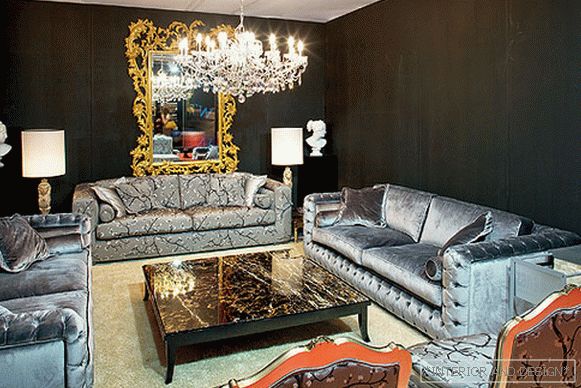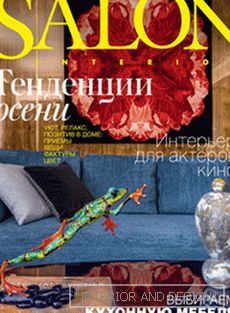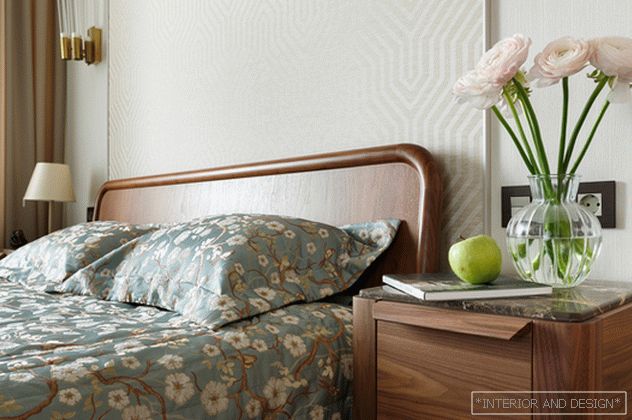Mattia Bonetti - European, designer with a thirty-year career. The buyers of his desks, consoles and cabinets are large collectors of modern art. He is one of those masters in whose work art and design converged on the same territory and live by the same rules.
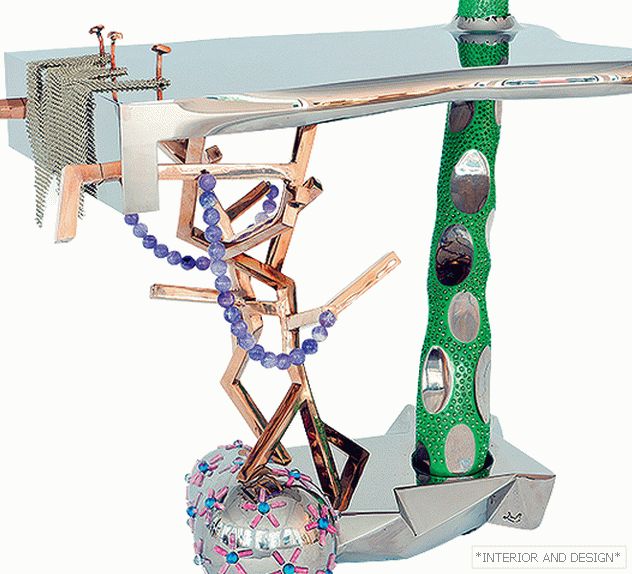 Depth console. In a complex form, beads, flowers, nails, chains, and branches are combined. The image is complex and incredibly fun, including thanks to the green color and lacuna ulcers covering the main element.
Depth console. In a complex form, beads, flowers, nails, chains, and branches are combined. The image is complex and incredibly fun, including thanks to the green color and lacuna ulcers covering the main element. That is why his fancy tables are perfectly alongside the works of Jeff Koons and the paintings of Keith Haring. Today, fans of Mattia Bonetti are enthusiastically exploring the weighty two-volume book devoted to his work, which was published by Editions Louvre Victoire. Fundamental work on the life of his life and masterpieces was written by two recognized experts, an expert on collection design Jacqueline du Pascier and an expert in decorative and applied art of the twentieth century, gallery owner Jean-Jacques Vattel.
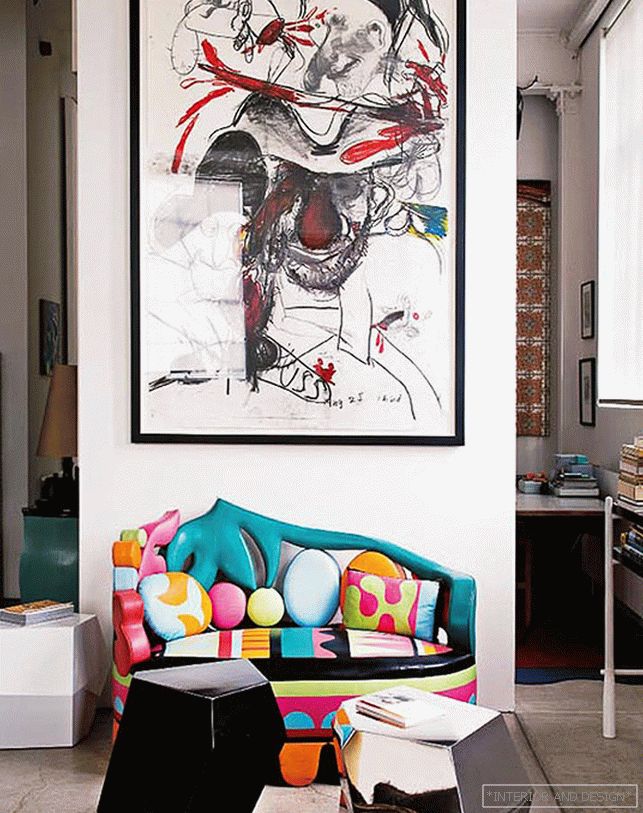 Sofa cut out in the interior.
Sofa cut out in the interior. Mattia Bonetti was born in 1952 in Lugano (Switzerland) in the family of an antiquary. Received an art education. He started as a fabric artist, was fond of photography. From 1980 to 2002, he performed in tandem with the talented designer Elizabeth Garust. Together with it, they decorated interiors, designed furniture in neo-baroque style.
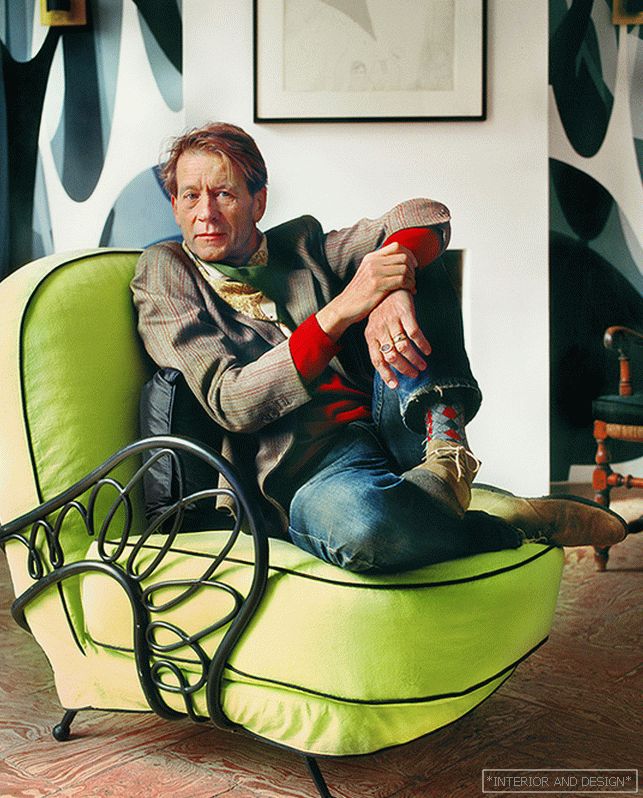 Mattia Bonetti on the armchair with wrought handles.
Mattia Bonetti on the armchair with wrought handles. Логотип Сhristian Lacroix, флаконы парфюма Nina Ricci, бутылки Paul Ricard с солнцем — все сделано дуэтом Garouste & Bonetti. Неслучайно, говоря о 1980-х годах, историки дизайна среди ключевых явлений упоминают три: группу Memphis, Филиппа Старка и фантазийное творчество Garouste & Bonetti. Дизайнеры продавали свои произведения в галереях, а также получали интересные интерьерные заказы. Именно они оформили дом модельера Кристиана Лакруа, с которым познакомились весной 1987 года.
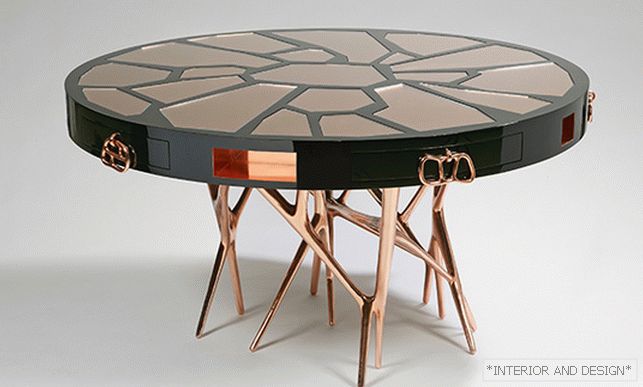 Table Nouveau Riche. Steel, nickel-plated aluminum, bronze, lacquer.
Table Nouveau Riche. Steel, nickel-plated aluminum, bronze, lacquer. “He showed us what he loved,” recalls Mattia Bonetti. “Lacroix talked about Provence, where he grew up, about the Baroque style, about the bullfight, about the art of Islam, about Spain.” All the words uttered by the couturier were peculiarly deflected in the imagination of the designers, so as a result of their work on the house, an absolutely dizzying mix from the rococo style with boudoir chic of the XIX century, chairs XVIII, upholstered in crimson, lilac, orange and blue fabrics, furniture with wrought iron legs in the form of intricate arabesques and table bases in the form of toothpicks. But Lacroix was delighted.
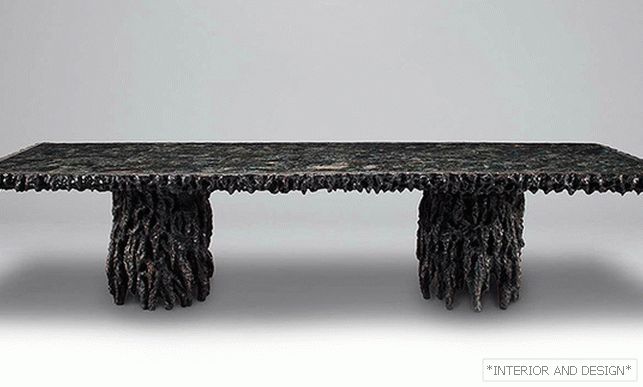 Dining table Atlantis. Bronze, marble.
Dining table Atlantis. Bronze, marble. At about the same time, Garuste and Bonetti began redecorating the castle of Bouagelu, 63 km from Paris, in which Picasso worked in the 1930s. The repair customer was the grandson of the famous painter Bernard Picasso. The design that Matttia Bonetti came up with was inspired by the master's cubistic period.
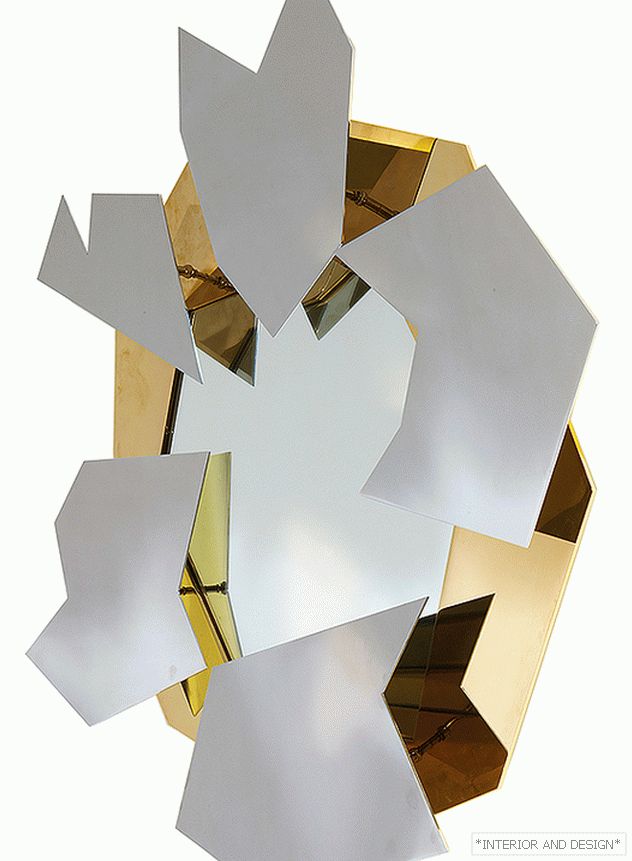 Brisee mirror in a frame, diz. M. Bonetti. Steel, aluminum, brass.
Brisee mirror in a frame, diz. M. Bonetti. Steel, aluminum, brass. 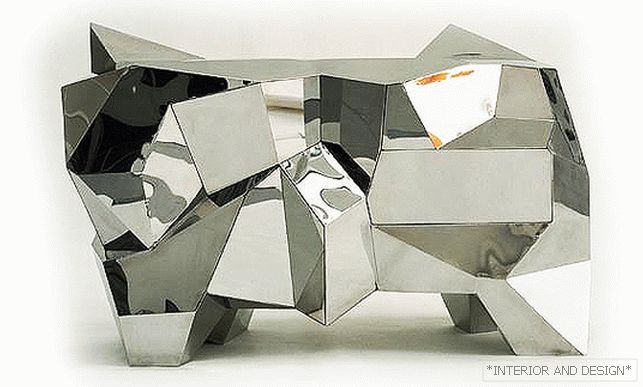 Chest Polyhedral. Stainless steel, lacquer, wood.
Chest Polyhedral. Stainless steel, lacquer, wood. Another famous pro customer was Countess Gloria von Thurn und Taxis. She invited Elizabeth Garust and Mattia Bonetti to remake their private apartment in Regensburg. Mattia decided to find out the client's tastes and asked what kind of flowers she likes. "Sunflowers," answered the Countess. And this determined the appearance of the living room with a purple sofa, bathed in bright yellow sunflowers, the work of the Parisian embroidery house by François Lesage. “The lamps looked like giant pink condoms, and all my friends ridiculed me! But I always wanted to live side by side with modern design and contemporary art, ”recalls Countess von Thurn und Taxis of a book about Mattia Bonetti ...
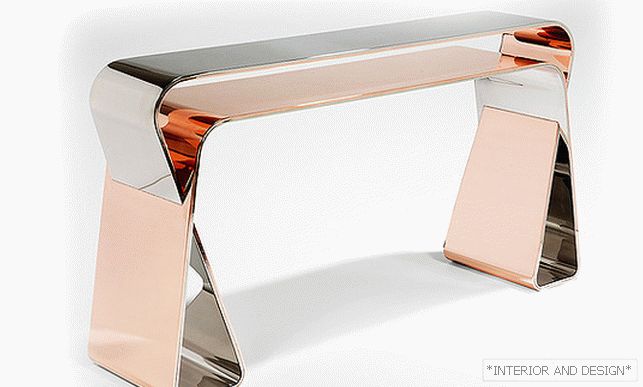 Endless Ribbon Console Brass, steel.
Endless Ribbon Console Brass, steel. Then the professional ways of Garust and Bonetti went their separate ways. Today Mattia works alone, creates only limited series. Everything created by the maestro is sold in London (David Gill Gallery) and New York (Paul Kasmin), and many objects are already included in the collections of the Victoria and Albert Museum, the Georges Pompidou Center and the Guggenheim Museum. “I am an individualist and have always been,” . - Mass is sick to me - both in life and in work. Therefore, I do not like to travel. Before the crisis, there were crowds of people everywhere, wherever you look - the same thing, all megalopolises turned into one continuous duty free store. I see the point in doing things in a single copy or in small batches. In the world of total multiplication and seriality, any item created in a single copy has a different value.
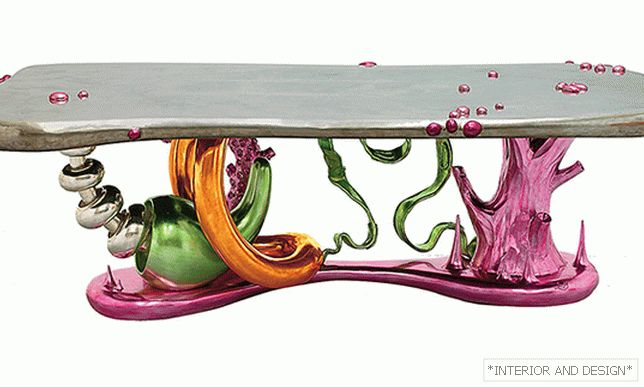 Abyss table. Nickel-plated aluminum, bronze, tinted lacquer.
Abyss table. Nickel-plated aluminum, bronze, tinted lacquer. 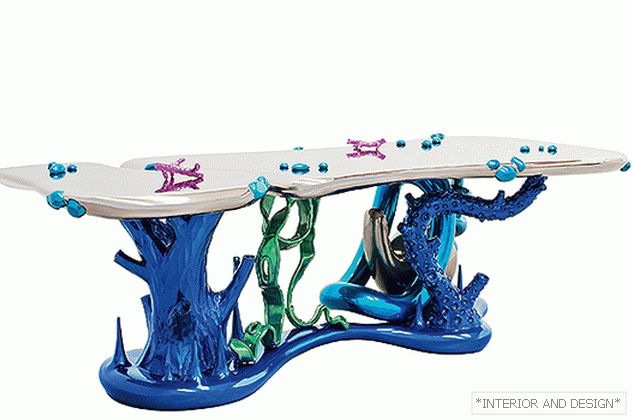 Abyss table. Nickel-plated aluminum, bronze, tinted lacquer.
Abyss table. Nickel-plated aluminum, bronze, tinted lacquer.
I try to make everything unique in my things: design, choice of materials, method of production ... Serial things, as a rule, are made of one material, maximum two. I have this figure reaches 4-5. I like variety, I like to combine Plexiglas, wood, metal. All materials hold the form in different ways. Polymers, of course, are universal: the most sophisticated idea with them becomes reality.
 Interior of a Paris apartment with a Meadow table and a Ula work chair.
Interior of a Paris apartment with a Meadow table and a Ula work chair. Crises have happened before, lasted for 8-10 years. But they did not knock me out of the rut, I just lived day after day and worked. Of course, you quickly get used to the good. Before the crisis, champagne flowed like a river, today I switched to red again and have no regrets about it. Another thing scares: a lot of homeless people on the streets of Paris. Seeing them hurts, because corporations and banks are still making millions. Twenty years ago, the originals of Corbusier or Eileen Gray were bought from antique dealers. There were few things. Now the market is full of replicas, repetitions, "stolen" design. In my opinion, this is a mortal longing. It is better to invest in new names, in promising novice designers. This is done by galleries, not chain stores. ”
 Sofa Cut Out, colored leather trim.
Sofa Cut Out, colored leather trim. 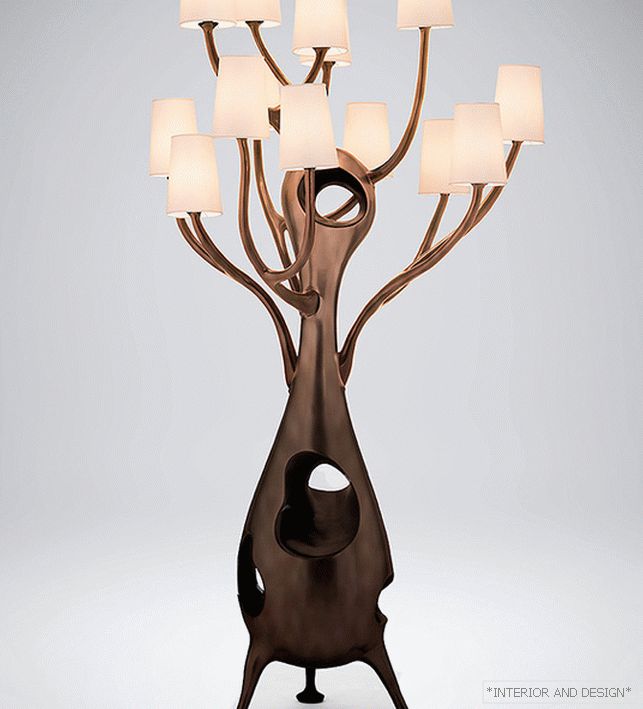 Floor lamp Metropolis. Patinated and lacquered aluminum. David Gill Gallery.
Floor lamp Metropolis. Patinated and lacquered aluminum. David Gill Gallery. 
